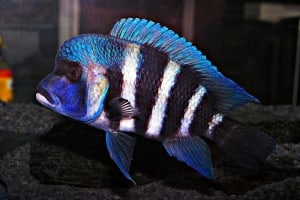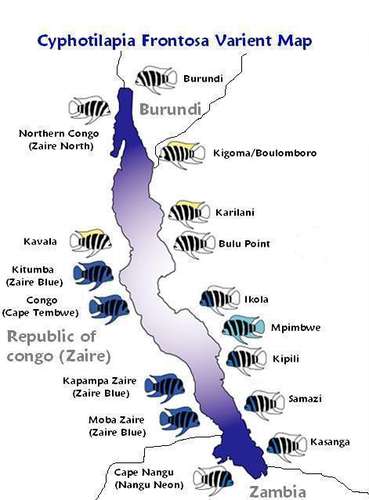
Common name: Frontosa, Northern Congo Frontosa, Kavala Frontosa, Kitumbu (Zaire Blue) Frontosa, Congo (Cape Tembwe) Frontosa, Kapampa Zaire (Zaire Blue) Frontosa, Moba Zaire (Zaire Blue) Frontosa, Cape Nangu (Nangu Neon) Frontosa, Burundi Frontosa, Karilani Frontosa, Bulu Point Frontosa, Ikola Frontosa, Kipili Frontosa, Samazi Frontosa, Kasanga Frontosa, Zaire Blue Frontosa, Kigoma Frontosa, Mpimbwe Frontosa, Front
Scientific name: Cyphotilapia Frontosa, Paratilapia Frontosa, Pelmatochromis Frontosus
Average Adult Fish Size: 30cm / 12 Inches
Place of Origin: Lake Tanganyika
Typical Tank setup: Rocky Tanganyika tank
Recommended Minimum Aquarium Capacity: 400 Litres
Compatibility: Other Frontosa ideally.
Temperature: 24-27 Deg C / 74-79 Deg F
Water chemistry: pH 7.6-8.6
Feeding: Omnivorous – does well with flake or pellet food. Can be fed freeze-dried or frozen krill or plankton as a treat.
Sexing: A large nuchal hump usually indicates the dominant male but is not always the case. Males grow larger and quicker than females so if a group has grown up together the largest is most likely a male. If the dominant male is removed a subdominant male will take its place. The most reliable way to sex these fish is by ‘venting’, which involves viewing the sex organs. There are two holes on each fish. The one towards the top is the anus. The one towards the bottom, closet to the anal fin, is the sex.
Breeding: Frontosa are harem spawners. Wild fish do best when one male is in a tank with 4-6 females. You can have more than one male but he will be harassed. Some people will put 2 or 3 males with 10 to 12 females in a homemade 400+ gallon tank. A large breeding colony can produce a hundred fry a month. Two things worth pointing out is that C. frontosa have huge eggs and that the incubation period for the eggs in excess of thirty days.
Additional Information: There are different variations of the popular Frontosa Cichlid which mainly come from slight colour variations although the Kigoma Frontosa has 7 black stripes on a white body whilst others have six black stripes on a white background. The extremities will stay white or light blue in colour. Both the male and the female will develop the cranial hump on the forehead but the male hump will be larger and more pronounced. The fish in the picture above is a juvenile because it has no cranial hump.
They are a gently tolerant community fish and don’t look for trouble, but they will defend a territory once they have established one. Even though they are quite peaceful beware of keeping smaller fish in your aquarium. The Frontosa will stealthily snatch up a small fishy snack if it is available! These are deep water fish rather than cave dwellers. They are best kept in groups of 8 to 12 in a very large aquarium with plenty of room to swim. A 150 gallon aquarium is recommended with a sandy bottom and rock structures creating fissures to hide in. Though plants are not essential, they do not burrow and will not harm them.
They can vary greatly in price with the most common and lowest cost type being the Burundi and the most sought after at the time of writing is the Zaire Blue Frontosa. This is primarily down to the Zaire blue type of Frontosa exhibiting more blue colouration on it’s head and the reason behind price differences being the countries and conditions of the collection points. Below is a map of the different Frontosa Collection points around Lake Tanganyika: It is common for people to want to buy wild caught or F1 variants of Frontosa (difference between F1 and WC) which is down to them being more likely to breed in early days and also due to the speed at which Frontosa grow. Although they will reach around 12 inches, it takes a long time (approx. 3-4 years) to get to this sort of size due to being slow growers.
It is common for people to want to buy wild caught or F1 variants of Frontosa (difference between F1 and WC) which is down to them being more likely to breed in early days and also due to the speed at which Frontosa grow. Although they will reach around 12 inches, it takes a long time (approx. 3-4 years) to get to this sort of size due to being slow growers.
The most distinctive difference between the more common Burundi Frontosa and those caught from other parts of the lake, except for the blueness of them is the front black stripe position. On the Burundi type of Frontosa the band goes directly over the head however on those not caught from Burundi area the band goes round the front of the face and over the eyes, looking very much like a mask, often referred to as a Zorro mask.
As we mentioned, the very much desired “Zaire Blue” Frontosa types covers those caught from collection points in Zaire which include the Kitumba, Kapampa and Moba types. Unfortunately many people in the hobby will assume all Frontosa are “Zaire Blue” types as their young are showing some blue colours however may be being mis-sold as the wrong type so when buying, do so with caution before parting with your hard earned cash!

Related Posts
Croaking Gourami – Trichopsis vittatus
Paradise Fish – Macropodus opercularis
Schubert’s Barb – Barbus Semifasciolatus